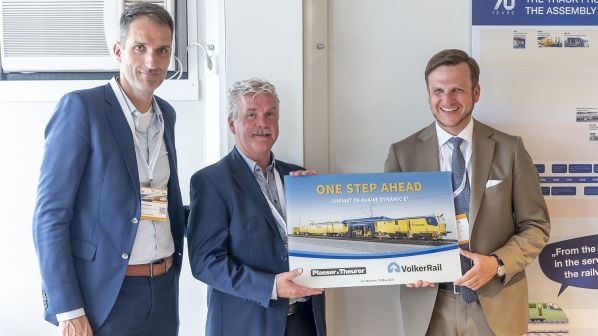IN his speech at a dinner hosted by Plasser & Theurer at the IAF exhibition in Münster on June 1, Mr Johannes Max-Theurer, the company’s CEO, said he was not going to talk about digitalisation, automation and artificial intelligence, themes that the audience of around 1500 delegates might have expected. Instead, he introduced a video, specially commissioned for the event, which featured track workers from around the world.
Max-Theurer stated that he wanted to shine a light on the people who make sure the trains run every day. From Brazil to France and Sweden, Japan and India, “The real heroes of the tracks” were shown working on a variety of track construction and maintenance projects.
The workers - all men - were given space to speak about their experiences during the nine-minute presentation. They talked about how they got into the job, their skills, the conditions they work in, and the attachment they feel to what they do. They also spoke of the sacrifices they have made, including spending a long time away from their families. “Many colleagues have lost their families as a result of the job,” one elder track maintenance worker from Poland said. “It is very tough.”
The stark reality of the demands of working on track, often at night and in tough weather conditions, is proving a more and more difficult sell for track maintenance companies. Coupled with an impending exodus of skilled workers who are approaching retirement, they are under pressure to find solutions that make the job more attractive. If they don’t, the risk to the railway is unfathomable.
From spending three days at IAF it was apparent that the supplier community is responding to this challenge by innovating. Plasser & Theurer has placed a great deal of thought into conditions for workers in the Unimat 09-8x4/4S BR Dynamic E3, for example, one of the highlights of its 19 exhibits (IRJ May p30). The machine’s two tamping operators are located in the same cab while social areas have been rethought to improve comfort. The use of live video streams is enhancing usability and safety for workers. Similarly, the use of electric power and traction is reducing emissions and the noise of the machines, making operation a more comfortable and safe experience.
Alternative traction is also creeping into track maintenance machinery. Linsinger’s MG11 Hydrogen, designed for metro networks and undoubtedly one of the star exhibits at IAF, is the world’s first hydrogen powered track maintenance machine. Railcare also exhibited a battery powered RailVac machine, the design of which has increased the overall payload compared with the diesel model on which it is based. In addition, virtually all handheld tools shown at the event were battery powered, with suppliers such as Robel and Geismar keen to point out that these machines offer similar if not better performance than their diesel equivalents.
Of course, many of the products and machines on show were prototypes. The suppliers were keen to excite the market and to open many customer’s eyes to the possibilities offered by innovation. There is no doubt room for further refinement, and by the time the next exhibition rolls around in May 2025, it is likely that many of these electric and innovative machines will be in use or on order for customers.
Automation of track maintenance is also likely to be a major theme of that event. Robel Rail Automation’s successful trials with an automated track defect repair concept hints at the possibility of these machines to take functions away from humans, improving safety and reducing demand on the workforce.
While an entirely automated track maintenance machine still appears a way off, work to develop these ideas is very much underway behind the scenes. It is not beyond the realms of possibility that the first of these machines will be ready to wow visitors at IAF in 2025 or 2029.
Plasser and VolkerRail reach agreement for the Unimat 09-8x4/4S Dynamic E³
PLASSER & Theurer announced the signing of a development partnership with VolkerRail, a subsidiary of VolkerWessels Group, during IAF for the Unimat 09-8x4/4S Dynamic E³, which was unveiled at the show.
Under the agreement, which Plasser describes as a milestone in the global transition to digitalised track maintenance, the Unimat 09-8x4/4S Dynamic E³ will join the VolkerRail fleet in the summer of 2024. Plasser & Theurer says the machine will be equipped with its latest and most sophisticated digital solutions.
Among them is the Plasser InfraScan measuring system, which collects data on structure gauge, ballast distribution, track platform and contact wire positions as well as the distance to the adjacent track. Plasser TampingControl will also be onboard and will automatically check ballast compaction, with results documented in the Plasser TampingReport.
In addition, the machine will introduce a new cab concept for turnout tamping where the workstation will be integrated with the continuously moving working cab, improving onboard conditions for workers.
The machine will be tested and finalised during operation on tracks in the Netherlands and both companies say they will work together to obtain necessary approval for operation on the Dutch network as soon as possible.
Linsinger hydrogen milling machines takes to the IAF tracks
LINSINGER unveiled the MG11 Hydrogen, the world’s first hydrogen-powered track milling machine, at this year’s event ahead of the start of trials with two European metros later this summer.
The four-axle machine is around 30m long and weighs 38.1 tonnes. Onboard, hydrogen storage tanks supply a 230kW fuel cell, which converts hydrogen into electricity via electrolysis. The electricity is used to charge 240kW batteries installed at the rear of the machine, which power the train’s traction system. The batteries are also available to provide back-up power to enable the train to move in the event of an emergency.
Linsinger says the machine has “almost the same” power output as an equivalent diesel unit. The MG11 H2 has a top speed of 60km/h and in addition to electricity, the only byproduct of electrolysis is water, which is released from the left-hand side of the unit, directly beneath the fuel cell.
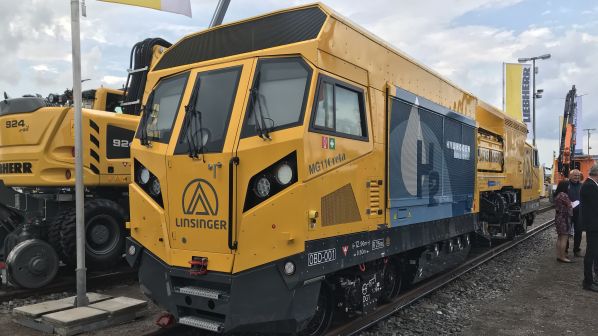
Linsinger says that combined with its no dust, no sparks milling process, the train is an attractive proposition for underground metro networks to address growing concerns about diesel emissions and excessive dust as a byproduct of grinding.
The supplier says it is ready to begin trials with two operators at the end of this month before the machine is shown at InnoTrans in September. Linsinger CEO, Mr Günter Holleis, would not reveal the identity of the operators, but as well as Europe he says networks in Japan are “very interested” in the potential of hydrogen infrastructure maintenance machines.
The project required a complete reconfiguration of the MG11’s interior layout compared with the standard diesel unit. Hybrid diesel-hydrogen options are also envisaged according to technical director, Mr Juergen Binder, who says Linsinger wants to ensure flexibility in its offer. It has worked alongside TÜV Süd throughout the development process to ensure the machine’s design complied with necessary regulations.
Linsinger has also worked with an external supplier on a mobile refuelling concept while Binder says the company is ready to work with network owners to install a fixed hydrogen refuelling facility at depots, a proposition he says is becoming increasingly viable. Refuelling takes around 30 minutes to complete, which Linsinger says is more attractive than an equivalent battery unit that may take seven to eight hours to recharge.
The MG11 is designed for use in tight profile metro networks and Holleis says it developed the hydrogen drive for this unit specifically so that it is scalable to its larger fleet of mainline machines. The company says it expects to show a second prototype, the MG21 H2, at InnoTrans in 2024.
Geismar launches electric track maintenance range
GEISMAR debuted a range of 11 battery powered hand-held track maintenance machines which use one design of battery which is fully interchangeable between machines.
The Activion battery weighs 10kg and has an output of 1.4kW. Geismar says this will give the same, or in some cases better, performance than an internal combustion engine because the battery produces constant torque as with the coach screwing machine.
It is also possible to retrofit existing Geismar machines to operate with the Activion battery so customers can switch to electric operation without having to buy new machines.
Geismar also exhibited its new Air Wizard bi-mode road-rail light rail catenary maintenance vehicle, which is powered by methane for travel between work sites, and is equipped with batteries with sufficient power to work for six to eight hours per shift. A major benefit of using batteries, apart from the elimination of pollution, is the reduction in noise compared with a diesel vehicle, an advantage when working at night.
The vehicle, which is based on a Renault truck, has an 8m² work platform measuring 4.3m by 2m which can be raised 5.5m above the rail head. The platform can also be rotated 100˚ in each direction and move up to 5m to the left or right of the track centre. In addition, the platform can be tilted to provide a level working area on canted track. The platform has a maximum payload of 1 tonne.
The first vehicle was built for Semitan, which operates the Nantes light rail network in France. Semitan also purchased two more similar machines from Geismar, one with a long-reach basket and the other for electrification mast replacement.
Goldschmidt developing prototype ultrasonic measuring system
GOLDSCHMIDT displayed a prototype ultrasonic measuring system designed to diagnose, inspect and check the quality of the rails before and after grinding or milling.
The modular system combines four different measuring devices:
• an eddy current system to detect rail surface defects
• a laser-based rail profile and rail corrugation measuring system which Goldschmidt says is the first such system on the market to meet the new European standard for rail profiles
• an ultrasonic wheel to measure defects in the rail metallurgy, and
• a video inspection system to examine and detect rail surface defects.
The prototype is now in the final phase of testing and approval, which should enable Goldschmidt to start marketing the system next year.
Robel unveils automated robot for track defect repair
A snapshot into the future of railway track maintenance was offered by Robel Rail Automation, which presented what it says is the world’s first fully automated rail defect repair platform.
Following development over the past two years, on-track trials have been carried out in a closed environment in Germany in recent months with the concept presented to the public for the first time in Münster.
The prototype is based on a track-based “box-in-a-box” system placed on a standard flat wagon. A 20ft container is equipped with the 30kW diesel, 24kWh battery hybrid power supply system as well as a working area for the system’s sole operator. The adjacent 40ft container includes the working space as well as an extendable robot frame, which acts as the working area when the system is in operation, extending the total length of the vehicle to 24.5m from 20m.

defect repair platform.
The working process is a fully automated track maintenance solution for local rail defect repair and requires the interaction of two collaborative robots; a six-axes welding robot with linear support and a six-axes tool changing robot. While fully automated, the track worker formally starts and stops the process, which takes approximately 1 hour to complete for small defects, and consists of five steps:
• defect detection using a 2D laser scanner, which creates a 3D image, and to which it is possible to add modular units including an ultrasound measurement sensor
• defect removal using a high-speed milling machine. A compressed air system blows away waste metal which is retrieved by suction
• defect repair consists of three stages: pre-heating using three ceramic heat plates operating at up to 1000˚C; 3D on rail welding using an automated Mig welding system; and scanning using the 2D/3D laser scanner
• reprofiling takes place initially with the milling element and is refined using a modified Robel 13.49 grinding machine, and
• a quality control check using the 2D/3D laser scanner.
Dr Michael Reiter, managing director of Robel Rail Automation, says the development of the concept is driven by a decline in track workers and issues with knowledge transfer for skilled processes such as rail welding. He says there is growing demand for accurate and quick track defect repair for increasingly utilised railway infrastructure and foresees a growing need for automated solutions in the future. “It also reduces the requirement for staff to work in the danger zone with one operator able to carry out the entire process onboard, improving safety,” he says.
While the prototype uses diesel, Reiter adds that hydrogen or even photovoltaic cells could be used to charge the battery. He says further improvements are expected and he envisages the product being available to the market in the next 18 months.
DRS Alliance seeks answers to issues of safety, efficiency and capacity
THE Plasser & Theurer exhibit included an area dedicated to the new Digital Railway Solutions Alliance (DRS) of 15 European track technology suppliers, which is aiming to adopt an “open innovation ecosystem” to increase the safety, efficiency, and capacity of the world’s railways.
The idea for an alliance to drive the adoption of digital solutions in railway infrastructure management was conceived in October 2021 during a two-day workshop, with the group’s plans formally announced at the IAF exhibition.
DRS says the commitment to increase rail’s share of global transport volumes in countries around the world means that maintaining high levels of safety, improving network efficiency, and increasing capacity are essential if rail is to succeed. As a result, the alliance is aiming to combine expert knowledge to develop and leverage new technologies and create overarching synergies for railway infrastructure managers and rail operators.
The founding members have identified what they believe are the key issues to resolve in track infrastructure management, identifying five priority areas on which they will initially focus, and which DRS believes will enable infrastructure managers to leverage the full value of digitalisation and new technologies:
• integrated sensor technology solutions: a holistic portfolio of superior, seamlessly connected and state-of-the-art sensor technology for all railway activities
• 3D+ infrastructure data solutions: an interactive 3D+ interface to monitor, access and maintain track assets by means of a digital twin, based on the combined expertise and sensor solutions of DRS Alliance Partners
• end-to-end asset data management: effective integration and utilisation of newly generated, digital asset data with historical data from paper and other archives
• AI-based predictive infrastructure management: modular solutions to optimise track and turnout management from assessment to execution, and
• automated services for trackside safety: automated track maintenance services communicating with the network’s train control system to schedule maintenance slots efficiently while keeping track workers safe.
“Following IAF, the DRS Alliance will immediately focus on strengthening end-to-end solutions for critical railway infrastructure in Europe,” says Mr Jan Mys, technical lead of the DRS Alliance and managing director of Global Rail Consulting, which is overseeing the alliance. “Starting in 2023 and beyond, we’re planning to expand further afield to help reshape rail mobility across the globe.”
“Our new alliance brings together best-in-class, technology-driven companies, each with a determined focus on optimising railway networks utilising the latest advances in digital innovation, automation and data processing,” says Mr Florian Auer, director of global technology and innovation at Plasser & Theurer. “Together, our combined expertise and complementary technologies will serve to tailor optimal solutions for each individual customer.”
SRT unveils rail grinding trains
SRT, Italy, which was exhibiting alongside its parent company Salcef for the first time at IAF, had two new types of rail grinding train on display: the Vulcano Heavy and the Vulcano Light.
Vulcano Heavy is available in scalable configurations from 22 to 96 grinding stones. The rail grinder is fitted with high precision motors and adjustable-angle stones with high abrasion capacity.
This machine is equipped with measuring systems for precise, continual recording of the condition of the rails before, during and after the grinding process, covering corrugations, rail cross-section and gauge. In addition, Industry 4.0 systems allow remote monitoring for real-time analysis of the machine’s performance and maintenance due dates.
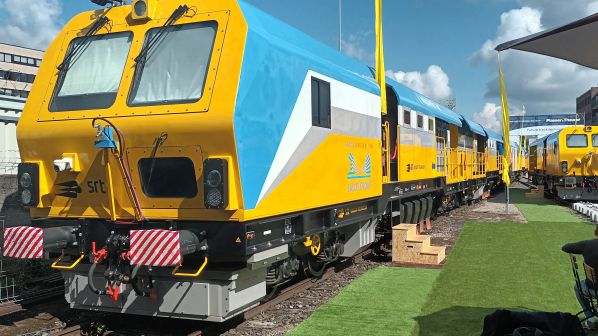
Vulcano Heavy comprises four different types of vehicles permanently coupled together: a pilot grinding module, an intermediate grinding module, a tank module, and a service module.
The Vulcano Light rail grinder is a self-propelled vehicle which can be supplied with 10 or 22 grinding stones. Thanks to its small loading gauge, the unit can also operate on metro lines. Vulcano Light has the same measuring system as Vulcano Heavy and is designed to grind rails in both plain line track and turnouts.
Vulcano Light can operate at a maximum speed of 100km/h, either as a towed vehicle in a train or as a self-propelled vehicle in a track possession area.
The first 10-stone Vulcano Light machine has been supplied for use on the new Line 3 of Riyadh Metro in Saudi Arabia.
Hilton Kommunal shows new road-rail catenary maintenance vehicle
HILTON Kommunal displayed a new road-rail catenary maintenance vehicle at IAF that it has built for electrification contractor Eqos Energie.
The vehicle is equipped with a variety of features to help Eqos complete different tasks, including: a Palfinger PKR 115 crane with a work basket capable of supporting a load of up to 280kg; a Palfinger PA1002 platform with three baskets; an additional outrigger; a Palfinger PFD 99 contact wire and cable positioner; a Schunk WBL 851-8810.4720 pantograph to measure horizontal contact wire position; and a non-contact ultrasonic wire measuring system.
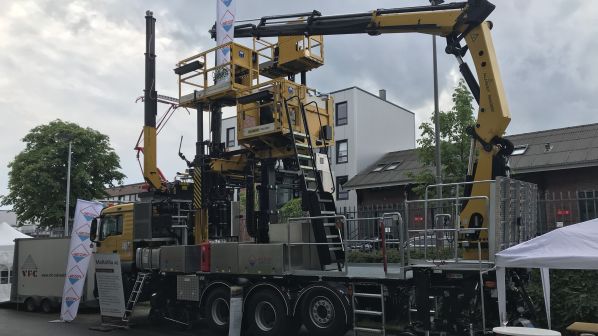
Mr Jan Diemont, sales manager at Hilton Kommunal, says developments in lightweight steel production over the past decade have enabled the supplier to increase the functionality and capability of its road-rail vehicles to conduct more maintenance tasks on the track, effectively closing the gap between road-rail vehicles and traditional track maintenance machines.
The vehicle is based on the chassis of a MAN TGS 35.470 8x4 BL truck. However, rather than relying on a traditional two-axle configuration, it has two bogies, developed in-house by Hilton Kommunal and equipped with four hydrostatically driven axles. The rear bogie features a 100o slewing range to ease the process of switching between road and rail. The vehicle can operate at a maximum speed of 24.9km/h when on track and weighs 32 tonnes.
Robel unveils metro milling train
ROBEL, Germany, handed over its first Romill Urban rail milling train to Plasser American on May 31. The train will now be shipped to Florida where it is due to arrive in August for operation on North American metro networks.
The three-car train has been developed jointly with Schweerbau International, which designed the patented climb milling process and polishing systems, and Vogel & Plötscher, which supplied the measuring equipment.
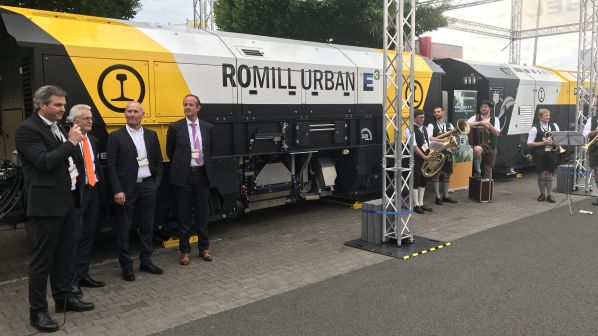
The train is designed to correct the rail profile and remove defects. The milling system comprises a 600mm milling head with 14 cassettes each of which can hold 18 tungsten carbide milling tools to achieve a very accurate rail profile. The orientation of the heads can be changed on the rail crown.
The rail grinding system which polishes the rails after milling is spark-free.
The train has a transverse laser system to measure the profile across the rail head and a longitudinal and transverse measuring system to check the quality of the milling and the finished rail profile. There is also an integrated eddy current detection probe to check for defects in the rail down to 2mm.
The train has a 400kW diesel engine and generator which can charge the three lithium-ion batteries up to 90% in around 90 minutes. There is also a shore charging facility which takes 15 hours to reach a 90% charge. Each battery can provide about 1 hour of travel and 1 hour of work.
The train can be operated by two people: a driver and an operative to monitor the milling process.
Robel has also built a main line version of the train, and the first three trains are being supplied to Japan.
Platform Basket extends product range
PLATFORM Basket, Italy, had on show a new lithium-battery powered version of its RR9/200 aerial railway platform. The compact machine weighs less than 3 tonnes which means it can be transported easily by road trailer between work sites, making it ideal for emergency use.
The RR9/200 has a working height of 9.2m and a 4.7m side reach. The two-seat work basket can carry a load of 200kg. The machine also has a self-levelling platform for working on canted track.
The machine has four flanged wheels for running on rails and two hydraulically-controlled retractable crawlers for getting on and off the track.
Platform Basket also had on show its new RR19/500 road-rail working platform which is equipped with a telescopic arm that can work up to a useful height of 19m with a payload of 500kg and three people on board the vehicle. The machine is self-levelling to compensate for a cant of up to 200mm.
The four-wheel drive RR19/500 has four rubber-tyred wheels and four retractable flanged steel wheels. It has a transfer speed of 19km/h and can travel at up to 5km/h when working with extended arms.
Matisa shows new measuring trolley
MATISA displayed its new inertial measuring trolley which it hopes will be certified by the end of 2022 or early 2023.
The compact inertial measuring unit is part of the Pegas track recording device and has sensors to indicate its position on the track. The unit is designed for optimal inscription in small radius curves.
The inertial platform is positioned on the centre line of the track independently of the gauge. The system has two integrated odometer sensors for wheel slip detection and curvature compensation. Pneumatic cylinders are provided for lifting, lowering and probing.
The inertial geometry compensation works at any speed, and the unit can operate in tunnels as it does not rely on GPS.
Matisa’s precision electronic geometry acquisition system has three tolerance levels. A PDF of the measurement segment can be uploaded to the cloud. It is possible to remotely monitor the machine to check its position and battery condition, for example.
